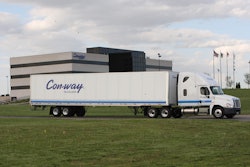The Federal Motor Carrier Safety Administration has revised current regulatory guidance on the applicability of the definition of a “driver” to “tillerman,” a person exercising control over the movement of a steerable rear axle on a commercial motor vehicle. The agency previously has determined that although a tillerman does not control the vehicle’s speed or braking, the rear-axle steering he/she performs is essential to prevent the trailer from off tracking into other lanes or vehicles or off the highway entirely, and because this function is critical to the safe operation of vehicles with steerable rear axles, the tillerman has been defined as a driver and thus subject to CMV regulations.
FMCSA said it recently has received inquiries from various entities, including the Professional Escort Vehicle Operators Association and the Specialized Carriers and Riggers Association, asking about other circumstances under which a person exercising control over a CMV’s steerable rear axle would be considered a driver of the CMV and thus subject to commercial driver’s license requirements.
The groups explained that the tillerman may not sit on the CMV, but walks alongside it to use a wired or wireless remote control to steer the rear axle; sometimes the tillerman may be in an escort car. These CMVs typically are specialized oversize vehicles on which the rear axle is steered only when “released” and when the CMV is moving at very slow speeds.
Under these circumstances, FMCSA said it does not believe that the person operating the steerable rear axle should be classified as a tillerman. CDL knowledge and skills testing would have little relevance to the remote-control operation of a steerable rear axle on an oversized CMV. FMCSA said it considers the tillerman’s physical location in, on, or around a CMV to be the most relevant factor in determining whether the person is a driver, and that anyone controlling a steerable rear axle from outside the CMV would be doing so under the direction of the person in the cab, and therefore should not be considered a driver.










